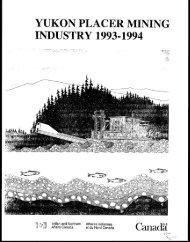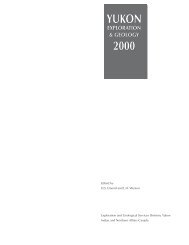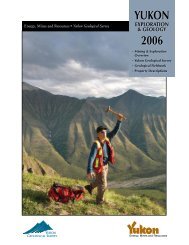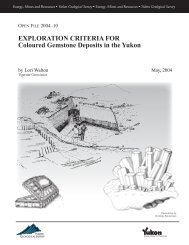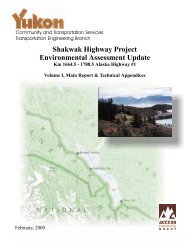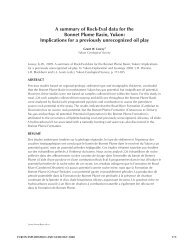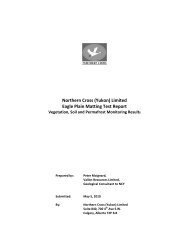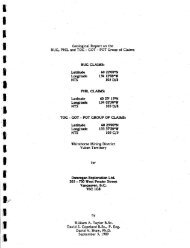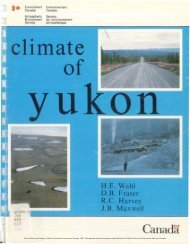WhiteCAP_Plan_01SEPT..
WhiteCAP_Plan_01SEPT..
WhiteCAP_Plan_01SEPT..
Create successful ePaper yourself
Turn your PDF publications into a flip-book with our unique Google optimized e-Paper software.
NCE <strong>WhiteCAP</strong> Environmental History<br />
Biophysical and climate research suggests that climate change may influence the<br />
frequency and intensity of forest fire activity in the northern boreal system 7 , 8 .The area<br />
surrounding Whitehorse is characterized by a relatively arid climate, thus an increase in<br />
average temperature and changes in the intensity and frequency of precipitation events<br />
could increase the risk of forest fires. Strong communication between the government,<br />
the public, and fire managers will strengthen adaptive capacity. Overall, public education<br />
campaigns and further monetary investment in fuel management will be important<br />
preventative measures that will help to ensure that residents are aware and prepared for<br />
potential changes in the forest fire regime due to climactic changes. Effective fuel<br />
management is expensive but must be maintained. Although a Firesmart program has<br />
instigated the clearing of underbrush (potential ignition fuel) in forest surrounding certain<br />
subdivisions, such measures will not undermine the need for quick institutional response<br />
should a fire break out. Future forest fires could become bigger and more intense if<br />
periods of drought are followed by sudden thunder storms which generate lighting. Given<br />
that there are more people living in and around Whitehorse these fires may become<br />
harder to fight. For example, there were 7.4% more residents in Whitehorse in 2006<br />
compared to 2001 9 . Large fires in the future may potentially threaten property and<br />
infrastructure more than ever before, especially in relatively remote areas on the<br />
periphery of the city.<br />
3.2 Flooding<br />
Flooding is an important environmental stress in Whitehorse and can occur year round,<br />
regardless of seasonal conditions. Flooding can cause damage to buildings, houses,<br />
bridges, roads, and sewage structures. Local vulnerability stems primarily from the<br />
Yukon River which traverses the city, one of the biggest rivers in North America. The<br />
Yukon River reacts quickly to shifting seasonal conditions because of its directional flow<br />
(the flows goes south to north) and its many tributaries. Seasonally, river levels rise in<br />
the fall and spring, driven by increased levels of precipitation, and ebb at the end of the<br />
summer. Cold weather can cause ice-jamming and flooding as the river does not freeze<br />
completely during winter months.<br />
3.2.1 Causes of Flooding<br />
There are numerous natural and anthropogenic reasons for flooding. In the spring, the<br />
river ice breaks and moves with the current; potentially creating conditions for an icejam,<br />
resulting in flooding. Ice jamming can also be problematic in winter when triggered<br />
by widely fluctuating seasonal temperatures, such as from very cold to very warm.<br />
Flooding can also result from the thawing of permafrost, which adds more water to the<br />
river. Permafrost can be melted by forest fires or by a heavy snowfall. Forest fires can<br />
melt about 3.6 metres of permafrost. Heavy snowfall can trap heat from the ground,<br />
acting as an insulator to melt permafrost, especially if the snowfall occurs early in the<br />
season.<br />
7 Duffy, P.A., Walsh, J.E., Graham, J.M., Mann, D.H. and Rupp, T.S. 2005. Impacts of large-scale<br />
atmospheric-ocean on Alaskan fire season severity. Ecological Applications 15:4, 1317-1330.<br />
8 Westerling, A. L., Hidalgo, H. G., Cayan, D. R., Swetnam, T. W. 2006. Warming and earlier<br />
spring increase western US forest wildfire activity. Science 313:5789, 940-943.<br />
9 2006 Community Profiles, Statistics Canada<br />
D.5



